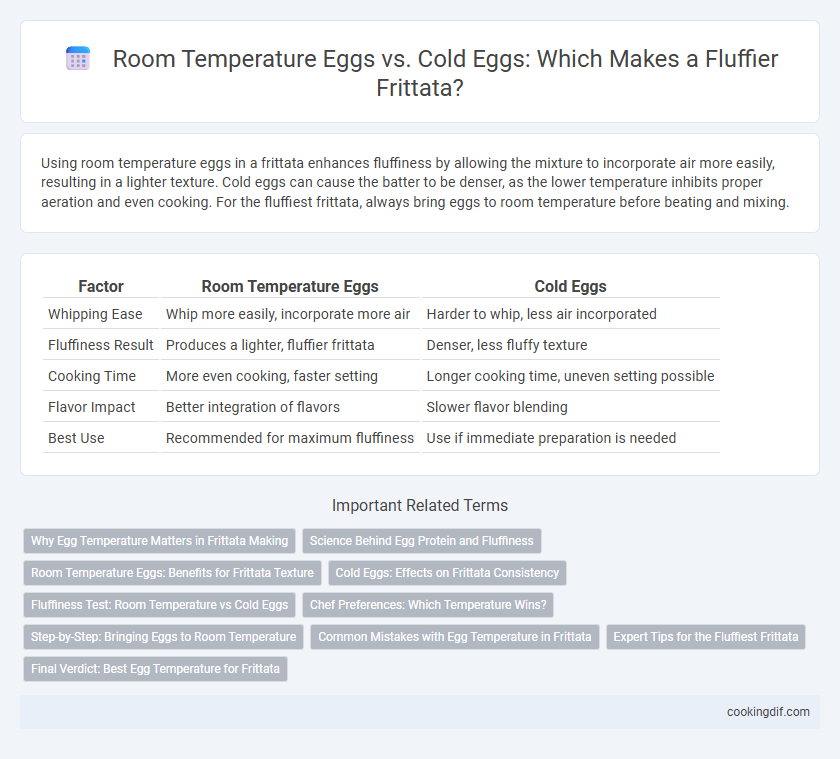Using room temperature eggs in a frittata enhances fluffiness by allowing the mixture to incorporate air more easily, resulting in a lighter texture. Cold eggs can cause the batter to be denser, as the lower temperature inhibits proper aeration and even cooking. For the fluffiest frittata, always bring eggs to room temperature before beating and mixing.
Table of Comparison
| Factor | Room Temperature Eggs | Cold Eggs |
|---|---|---|
| Whipping Ease | Whip more easily, incorporate more air | Harder to whip, less air incorporated |
| Fluffiness Result | Produces a lighter, fluffier frittata | Denser, less fluffy texture |
| Cooking Time | More even cooking, faster setting | Longer cooking time, uneven setting possible |
| Flavor Impact | Better integration of flavors | Slower flavor blending |
| Best Use | Recommended for maximum fluffiness | Use if immediate preparation is needed |
Why Egg Temperature Matters in Frittata Making
Egg temperature critically influences frittata fluffiness by affecting how well air incorporates during mixing. Room temperature eggs whisk more easily, trapping more air that expands during cooking, resulting in a lighter, fluffier texture. Cold eggs resist whipping, reducing volume and yielding a denser, less airy frittata.
Science Behind Egg Protein and Fluffiness
Room temperature eggs create a fluffier frittata due to the enhanced ability of egg proteins to trap air bubbles and expand during cooking. Cold eggs have tighter protein structures that coagulate more quickly when heated, resulting in a denser texture. The science behind this lies in protein denaturation and coagulation kinetics, which favor air incorporation and stability at warmer temperatures.
Room Temperature Eggs: Benefits for Frittata Texture
Room temperature eggs blend more evenly with other ingredients, creating a smoother, more uniform batter that traps air better, resulting in a fluffier frittata. The warmth of the eggs allows proteins to coagulate gently during cooking, enhancing the texture without becoming rubbery. Using room temperature eggs also shortens cooking time and promotes consistent rising, contributing to an airy and tender frittata.
Cold Eggs: Effects on Frittata Consistency
Cold eggs lead to a denser and less fluffy frittata due to slower coagulation during cooking, which affects the overall texture. The temperature difference causes uneven cooking, resulting in a firmer, more compact consistency. Using cold eggs can prevent the frittata from rising properly, thereby reducing its lightness and softness.
Fluffiness Test: Room Temperature vs Cold Eggs
Room temperature eggs create more air incorporation in the frittata mixture, resulting in a noticeably fluffier texture after cooking compared to cold eggs. The Fluffiness Test shows that whisking room temperature eggs allows proteins to trap air bubbles more effectively, which expands during baking for a lighter, more tender frittata. Using chilled eggs often leads to denser, less aerated frittatas due to reduced protein flexibility and slower foam formation.
Chef Preferences: Which Temperature Wins?
Chef preferences often lean towards room temperature eggs for achieving maximum fluffiness in a frittata, as they blend more smoothly with other ingredients and cook more evenly. Cold eggs can cause the frittata to cook unevenly, potentially resulting in a denser texture and less rise. Chefs prioritize the temperature of eggs because room temperature eggs expand more readily during cooking, enhancing the frittata's airy, delicate structure.
Step-by-Step: Bringing Eggs to Room Temperature
Bringing eggs to room temperature before making a frittata enhances fluffiness by allowing better incorporation of air during whisking. Start by removing eggs from the refrigerator 30 minutes prior to cooking or placing them in a bowl of warm water for 5-10 minutes to speed up the process. Room temperature eggs blend more evenly with other ingredients, resulting in a lighter, more tender frittata texture.
Common Mistakes with Egg Temperature in Frittata
Using cold eggs straight from the refrigerator can cause uneven cooking and a dense frittata, as they do not blend as smoothly with other ingredients. Room temperature eggs incorporate air more effectively, leading to a fluffier texture, yet a common mistake is failing to allow eggs to warm sufficiently before mixing. Ensuring eggs are at room temperature helps prevent curdling and improves the overall rise and lightness of the frittata.
Expert Tips for the Fluffiest Frittata
Using room temperature eggs for frittata preparation results in a noticeably fluffier texture compared to cold eggs. Experts highlight that bringing eggs to ambient temperature allows proteins to incorporate air more effectively during whisking, enhancing volume and creating a lighter dish. For the fluffiest frittata, crack eggs into a bowl and let them sit at room temperature for 15 to 30 minutes before blending with other ingredients.
Final Verdict: Best Egg Temperature for Frittata
For the fluffiest frittata, using room temperature eggs is ideal as they blend more evenly, incorporating air better and ensuring a lighter texture. Cold eggs can cause uneven cooking and a denser consistency due to temperature shock when they hit the hot pan. The final verdict is that room temperature eggs enhance frittata fluffiness by promoting uniform cooking and optimal rise.
Room temperature eggs vs Cold eggs for Frittata fluffiness Infographic

 cookingdif.com
cookingdif.com